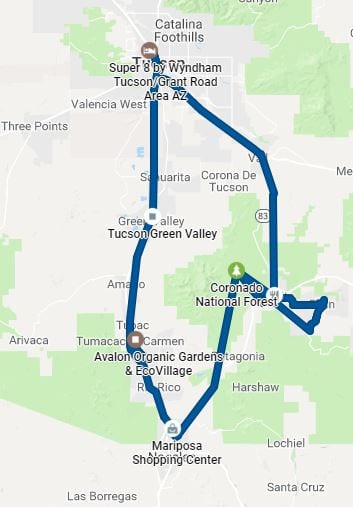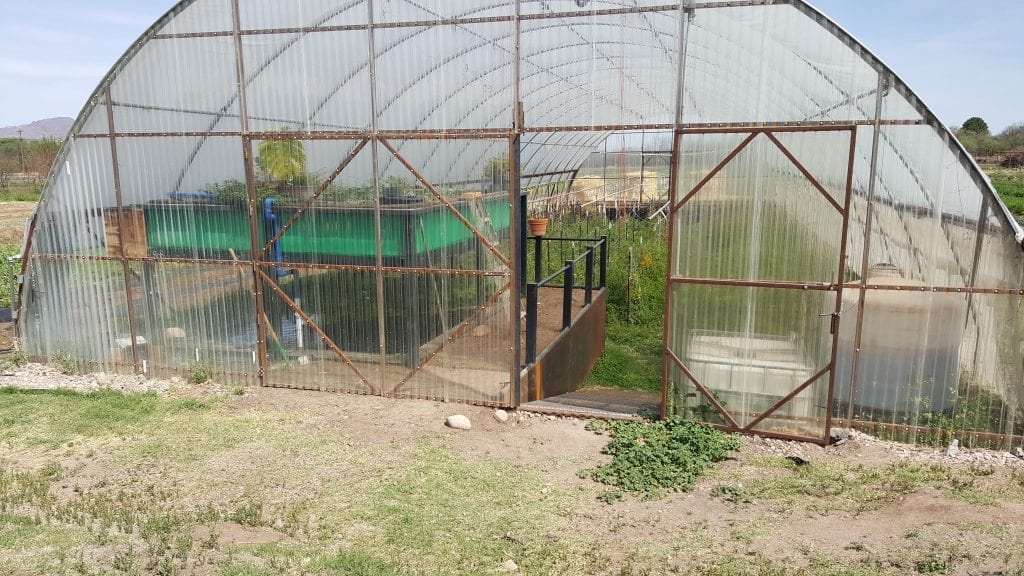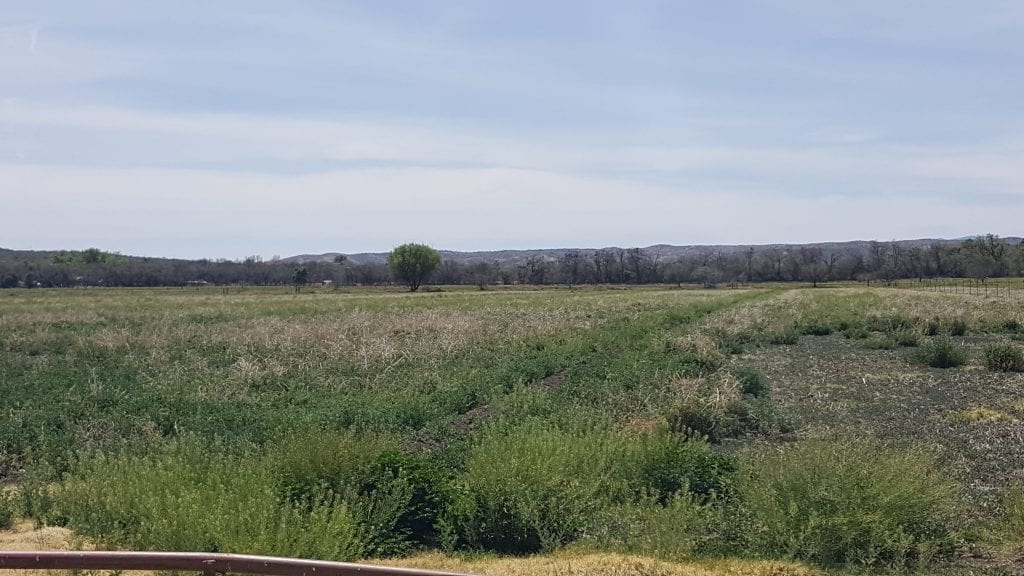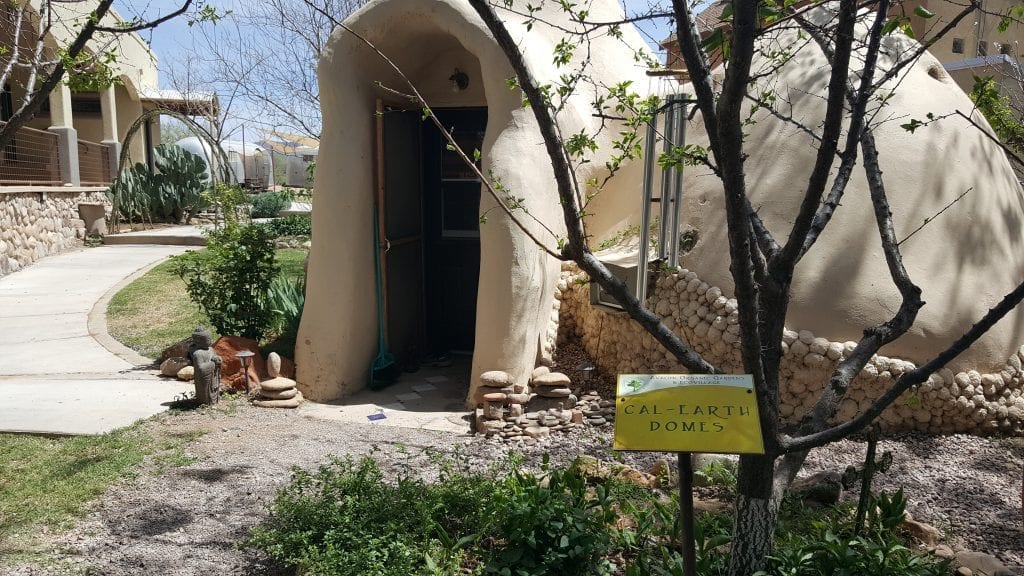Avalon Organic Gardens & Ecovillage – Summary:
- Who: TaliSeen JahRing
- What: Toured and had lunch at the Avalon Organic Gardens & Ecovillage
- When: Friday, April 6
- Where: Tumacacori, AZ
Quick Resources:
- Avalon Organic Gardens & Ecovillage Webpage
- Avalon Organic Gardens & Ecovillage Facebook Page
- The Avalon Country Store Webpage
- The University of Ascension Science and The Physics of Rebellion (UASPR)
- Global Community Communications Alliance (GCCA)
- The Urantia Book Webpage
My Route:
Planning my Eco-Inspired Road Trip Blog Post
My Travel Story:
I started the day with a personal tour led by TaliSeen JahRing, the Farm Manager of Avalon Organic Gardens & Ecovillage (AOGE), an impressive ecovillage model with stacks of sustainability initiatives and green projects, built on a strong Christian foundation, spiritual exploration, vocational learning and training, and organic permaculture practices.
On my way to AOGE, I pulled over at a rest stop to take a phone call, and came across this rock – which really set the tone for the day!
“Avalon Organic Gardens & Ecovillage is one of the world’s largest and longest sustaining EcoVillages, situated on 220-acres of historic & sacred agricultural land in Southern Arizona’s fertile Santa Cruz River Valley. At Avalon Gardens, over 115 dedicated individuals practice farming using traditional permaculture principles and time-honored techniques of organic gardening, as well as new sustainable technologies. We have people from all over the world with a diverse age groups and cultural backgrounds.
We are a fully operational micro-society showcasing the success we have had incorporating a modern lifestyle within the sustainable context of a land-based society. In addition to pursuing the classical “off-grid” definition of sustainability, the EcoVillage also pursues self-sufficiency by providing meaningful vocational work, ongoing education, spiritual exploration, and dynamic cultural experiences to each of the committed, residential members of the EcoVillage.
For members of the EcoVillage, life here is an ongoing statement of disagreement with the predominant system of greed and extortion that rules Western, consumerist lifestyles. We feel our lifestyle is an example of direct action and solutions for change. We actively promote the emergence of new-paradigm organizational patterns by beginning with a value system based on honesty, integrity, and stewardship of the environment. This is a living experiment of believing in the more beautiful world we all know is possible. We seek to create regenerative and nourishing systems that wholly capture the multifaceted meanings of permaculture and sustainability.
For over 25 years we have built both physical infrastructure, in the form of our buildings, gardens, and tools, as well as spiritual infrastructure, in the form of strategies, diversions, and counselors to promote conflict-resolution, cooperative work skills, and honest communication. By consciously merging the physical and spiritual worlds in this way, we work to create a reality within the EcoVillage that demonstrates “spiritual physicality” – the realization of spiritual ideals through tangible progress.” – AOGE Webpage
AVALON GARDENS & ECO VILLAGE IN TUMACACORI, ARIZONA – Supporting Blog Post
EcoVillage residents live apart, reach out – Nogales International Supporting Article
This is the initial view of the community from the public parking lot after driving down the entrance road. The community has had many issues with flash flood rains eroding the parking lot – so they created swales mounds and trenches round the parking lot which have stopped the erosion.
Here is a rain swale trench near the children’s playground dust fence that directs the water towards the desert plants and shade trees nearby.
The tour started near the entrance with one of the largest food forest swale systems in the southwest, which famed permaculture designer Geoff Lawton helped design remotely. The swales were inter-planted with fruit and nut trees, and served as rotational grazing for the free-ranging flocks of chickens – that were primarily sustained by the organic feed from the trees with very minimal supplemental feed.
These are some of the compost mounds where food is slightly covered so the chickens can scratch and forage, while adding fertilizer to the mounds and churning the organic material.
A few steps away was a large permaculture catfish cultivation pond, which served as a source of protein and fish fertilizer for the community.
On the other side of the catfish pond were the main fields for growing the organic crops. I arrived on a day were they were planting nut trees along the border of the main fields and the catfish pond and the food forest swale system, which had been a project long in the making.
Also in the main field was a lone greenhouse for hydroponics, which was below ground level to utilize gravity for watering the indoor plants.
Here’s a view of inside the greenhouse, where the fish are located in the concrete holding tank under the raised turquoise hydroponic table.
Our next stop was one of the many alternative architecturally built structures on site, this one was a strawbale music and worship sanctuary. This is where the worship team practices and performs, as well as the community band practiced for fun and other events.
We made our way to the produce processing buildings, where the vegetables were brought from harvest to be cleaned, processed and packaged for distribution.
TaliSeen went through the current system of how things were done with the latest updates, and then showed me some of the hand-built technology some of the residents made for cleaning the vegetables.
This is DIY produce washer built from a washing machine motor with a removable perforated trashcan that can be easily removed and refilled with another load of produce.
He also took me to the cold storage rooms and showed me some of their organizational charts based on a Japanese style of organizing.
He also took me to their main organizational headquarters, which had walls and walls of whiteboards that were laid out to correspond with the physical location of the fields, the specific produce, and planting/harvesting timelines for each row of produce. It was hard for me to wrap my head around such a system.
After, we made our way into the heart of the community where most of the retreats, events, classrooms and residents presided.
We walked by the center pond which featured an outdoor covered amphitheater for some of their events like the Earth Harmony Festival.
Then we strolled over to the permanent yurt complex, which was the community’s on-site school for the children. Education was tailored for each age group, and each child individually. Education is a cornerstone at Avalon, not only in terms of vocational training, but Niánn Emerson Chase, Avalon Organic Gardens Co-Founder and Executive Director of the Global Community Communications Schools, has had more than 40 years of teaching, counseling, and administrative experience across various age groups in both public and private school systems – so it was an embedded emphasis from the beginning.
After the classroom visit with the children, we made our way over to the onsite nursery and propagation green houses, which backed up to the emu pens.
On the far side of the plan nursery was a large conservation field for nature and wildlife preservation.
We then walked up to one of the original main buildings on-site, which held community office spaces, a large library, and spiritual practice rooms for religious services and events.
This is also where I learned about one of AOGE’s key pieces of literature as part of their studies, The Urantia Book.
“The Urantia Book, first published by Urantia Foundation in 1955, presents us with the origin, history, and destiny of humanity. It answers questions about God, life in the inhabited universe, the history and future of this world, and it includes an uplifting narrative of the life and teachings of Jesus.
The Urantia Book portrays our relationship with God the Father. All human beings are the sons and daughters of a loving God and therefore brothers and sisters in the family of God. The book provides new spiritual truth for modern men and women and a pathway to a personal relationship with God.
Building on the world’s religious heritage, The Urantia Book describes an endless destiny for humankind, teaching that living faith is the key to personal spiritual progress and eternal survival. It also describes God’s plan for the progressive evolution of individuals, human society, and the universe as a whole.” — Urantia Foundation Webpage
In front of this building was also an experimental natural grey-water filtration treatment garden, which purified the grey-water naturally before it flowed into the main center pond.
It was then time for lunch, and we walked through the main residential complexes that were made up of many different styles of architecture, like: monolithic domes, spray foam cylindrical pods, stacked insulated shipping containers, cob plastered earthbag domes, airstream travel trailers, and more strawbale structures.
These pair of sandbag and papercrete domes were built through workshops from the Cal-Earth Institute!
Before lunch, we made a pit stop to the main communal facilities – which was a strawbale building with restrooms and lime-plastered walls, which fed grey-water into the attached exotic plant greenhouse which helped regulate seasonal temperature.
After eating a delicious home-cooked, homegrown organic vegetarian lunch, I left feeling overwhelmed and inspired by what I saw during my visit!
More about Avalon Organic Gardens & Ecovillage:
The following articles and blog posts address some of the controversy about Avalon Organic Gardens & Ecovillage in terms of their local community developments, personal beliefs, process of joining and general lifestyles.
Personally, I like the AOGE’s mission and would gladly go back to learn skills that they have perfected, but after my own research, joining the community is not something I would be interested in as I feel like my path will take me elsewhere in the world.
- 10 Things I learned at Avalon Organic Gardens – Blog Post
- Group seems peaceful, but some neighbors are nervous – News Article
- Controversial Tumacacori church buying up Tucson properties – News Article
- EcoVillage residents live apart, reach out – News Article
- Tour operators educate visitors, dispel fears – News Article
- Preserving Dateline’s Exposé on Gabriel of Sedona – News Transcript
- An Undercover Report About Gabriel of Sedona (& Related Articles) – News Transcript
- An Open Letter To Those Who Have Been Influenced By NBC Dateline – GCCA Article
- The Cost of Being an Activist – Blog Post










































